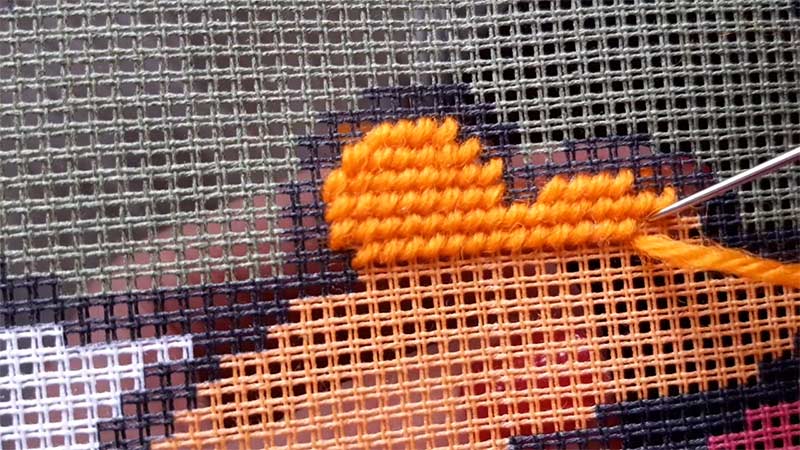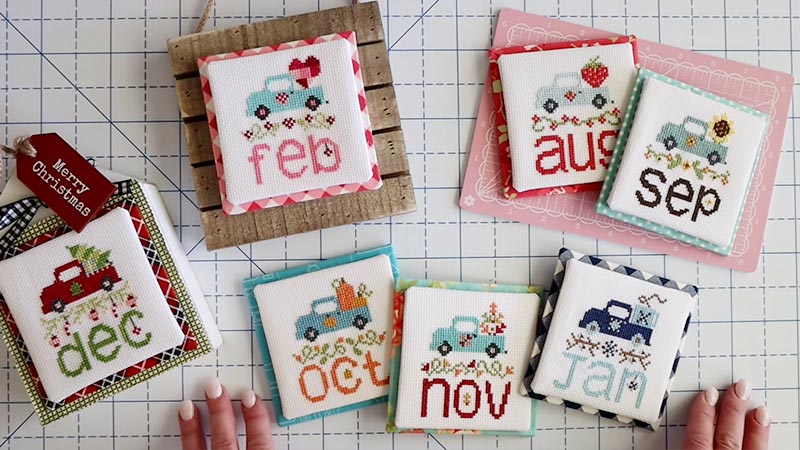Half cross stitch, often referred to as “tent stitch,” is a fundamental embroidery technique that brings a touch of simplicity and elegance to the world of needlework.
This unique form of embroidery involves creating just one-half of the familiar “X” shape, simplifying the stitching process and producing a more delicate, subtle effect. It’s aptly named “half” cross stitch because of this distinct feature.
Half cross stitch is often favored for its versatility, making it accessible to both novices and experienced embroiderers.
It’s a key stitch in a needleworker’s toolkit, frequently used to achieve subtler details in a wide array of creative projects, from sampler embroidery to clothing embellishments and beyond.

What Is Half Cross Stitch Called?
Half cross stitch is a basic and widely practiced embroidery technique. Instead of forming the typical “X” shape in full cross stitch, it involves creating only a single diagonal stitch, which constitutes half of that “X.”
This simplicity is one of its defining features, making it accessible to beginners and experienced embroiderers alike. It is used on fabrics with a visible grid, such as Aida cloth, which aids in maintaining a consistent stitch size and placement.
Characteristics of half cross stitches:
Simplicity and Accessibility
Half cross stitch is an excellent starting point for individuals new to embroidery. It’s easier to learn and execute than full cross stitch, making it a stepping stone for those who want to explore more complex stitches later on.
Delicate Appearance
This technique is favored when a more delicate or subtle appearance is desired in the final design. The single diagonal stitch creates a less dense and more open texture, allowing for a softer look.
Grid-based Work
Half cross stitches are typically worked on fabrics with a visible grid or mesh, such as Aida cloth or even weave fabric.
The grid assists in maintaining the consistency of stitch size and placement, ensuring a neat and orderly pattern.
Versatility
While half cross stitch is often used on its own for specific design elements, it is incredibly versatile and can be combined with other stitches.
It complements full cross stitches and backstitches exceptionally well, allowing for a wide range of textures and effects.
Speed and Efficiency
Due to its simplicity and reduced number of steps, half cross stitch is generally faster to complete than full cross stitch.
This makes it an excellent choice for large or intricate designs where time efficiency is a consideration.
Application
Half cross stitch is a common technique used in a wide range of embroidery projects, including wall hangings, samplers, pillow covers, and even clothing embellishments. It also plays a significant role in the creation of tapestries and needlepoint designs.
Thread Selection
Just like in full cross stitch, the choice of thread plays a crucial role in achieving the desired effect. Embroidery threads such as floss, silk, or wool can be used in half cross stitch, depending on the texture, color, and style you wish to achieve in your project.
Uses of Half Cross Stitch in Creative Projects

Half cross stitch, often referred to as tent stitch, is a versatile embroidery technique that finds application in a wide range of creative projects. Its simplicity, delicacy, and ability to add subtle texture make it a valuable tool for both beginners and experienced embroiderers.
Here are some common uses of half cross stitch in creative projects:
Cross-Stitch and Needlepoint Designs
Half cross stitch is frequently used in traditional cross-stitch patterns and needlepoint canvases.
It’s employed to create softer lines, and subtle shading, or to add detail to larger cross-stitched designs.
Sampler Embroidery
Samplers are a classic form of embroidery where different stitches and patterns are showcased. Half cross stitch is often used to create delicate borders, alphabets, or small motifs within sampler projects.
Monogramming
For monogramming and personalization of items like towels, handkerchiefs, or clothing, half cross stitch can be used to create elegant, lightweight initials and names.
Clothing Embellishments
Half cross stitch can add a touch of sophistication to clothing items. It’s often used for embellishing collars, cuffs, pockets, or even as subtle accents on dresses, blouses, and other garments.
Home Decor
This technique is employed to create decorative elements for the home, such as throw pillows, tablecloths, and curtains.
Half cross stitch can be used to craft delicate floral patterns, borders, or any subtle design element.
Tapestry and Needlepoint Canvases
In the creation of tapestries and needlepoint canvases, half cross stitch is used to add fine details and shading. This is particularly useful in reproducing intricate paintings or images in thread.
Miniature Embroidery
For miniature or dollhouse projects, where space is limited, half cross stitch is an excellent choice for creating intricate patterns on tiny pieces of fabric.
Children’s Craft Projects
Due to its simplicity and ease of execution, half cross stitch is often introduced to children as a fun and approachable craft. It can be used to teach basic stitching skills and creativity from a young age.
Custom Greeting Cards
Half cross stitch can be used to add a unique touch to handmade greeting cards. Stitching small motifs or initials on cardstock can create personalized and memorable cards for special occasions.
Cross-Stitched Jewelry
Cross-stitched pendants, earrings, and other jewelry pieces can be created using half cross stitch. The delicacy of this technique allows for intricate, wearable designs.
Mixed Media Art
In mixed media artwork, half cross stitch can be combined with other artistic elements to add a textural component. It can be used to represent fine details in mixed media pieces.
Embroidery on Wedding Accessories
Half cross stitch is often used on wedding accessories like ring bearer pillows, handkerchiefs, and bridal garters to add a personalized and delicate touch to these special items.
FAQS
Why is it called a “half” cross stitch?
It’s termed “half” cross stitch because, unlike the traditional cross stitch, it only creates one diagonal half of the “X” shape, simplifying the stitching process and achieving a more delicate appearance.
Can you mix half cross stitches with other stitches in the same project?
Yes, half cross stitch can be combined with various embroidery stitches to add depth and texture to your project. It pairs well with full cross stitches, backstitches, and even French knots.
Is half cross stitch suitable for very fine fabrics like silk or linen?
Half cross stitch can be adapted to finer fabrics like silk or linen, but it’s more commonly used on gridded fabrics such as Aida cloth, which provides a clear structure for stitching.
Are there any limitations to using half cross stitch in terms of design complexity?
While half cross stitch can be used in complex designs, it may not be ideal for highly detailed or intricate patterns. It’s best suited for designs where a softer, more open texture is desired.
Can you create shading effects with half cross stitch?
Yes, shading effects can be achieved with half cross stitches by varying the number of strands or colors of embroidery floss used in individual stitches. This technique can add depth and dimension to your work.
To Recap
Half cross stitch, aptly named “tent stitch,” stands as a cornerstone in the realm of embroidery, offering a unique approach to creating intricate designs with elegance and simplicity.
Its distinction lies in crafting just one diagonal half of the “X,” which imparts a delicate and subtle appearance.
This technique, renowned for its versatility, finds application in a myriad of creative projects, from sampler embroidery to personalized clothing embellishments, and even the restoration of historical tapestries.
Whether employed on its own or combined with other stitches, half cross stitch remains an indispensable tool, inviting both novices and seasoned embroiderers to add depth, texture, and artistry to their needlework endeavors.
Leave a Reply